
Symbiosis is any type of a close and long-term biological interaction between two different biological organisms, be it mutualistic, commensalistic, or parasitic. The organisms, each termed a symbiont, must be of different species. In 1879, Heinrich Anton de Bary defined it as "the living together of unlike organisms". The term was subject to a century-long debate about whether it should specifically denote mutualism, as in lichens. Biologists have now abandoned that restriction.

Siboglinidae is a family of polychaete annelid worms whose members made up the former phyla Pogonophora and Vestimentifera. They are composed of about 100 species of vermiform creatures and live in thin tubes buried in sediments (Pogonophora) or in tubes attached to hard substratum (Vestimentifera) at ocean depths from 100 to 10,000 m. They can also be found in association with hydrothermal vents, methane seeps, sunken plant material, or whale carcasses.

In biology and medicine, a host is a larger organism that harbours a smaller organism; whether a parasitic, a mutualistic, or a commensalist guest (symbiont). The guest is typically provided with nourishment and shelter. Examples include animals playing host to parasitic worms, cells harbouring pathogenic (disease-causing) viruses, a bean plant hosting mutualistic (helpful) nitrogen-fixing bacteria. More specifically in botany, a host plant supplies food resources to micropredators, which have an evolutionarily stable relationship with their hosts similar to ectoparasitism. The host range is the collection of hosts that an organism can use as a partner.

Riftia pachyptila, commonly known as the giant tube worm, is a marine invertebrate in the phylum Annelida related to tube worms commonly found in the intertidal and pelagic zones. R. pachyptila lives on the floor of the Pacific Ocean near hydrothermal vents, and can tolerate extremely high hydrogen sulfide levels. These worms can reach a length of 3 m, and their tubular bodies have a diameter of 4 cm (1.6 in). Ambient temperature in their natural environment ranges from 2 to 30°C.
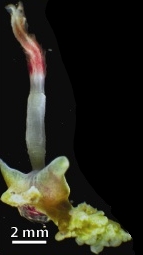
Osedax is a genus of deep-sea siboglinid polychaetes, commonly called boneworms, zombie worms, or bone-eating worms. Osedax is Latin for "bone-eating". The name alludes to how the worms bore into the bones of whale carcasses to reach enclosed lipids, on which they rely for sustenance. They utilize specialized root tissues for bone-boring. It is possible that multiple species of Osedax reside in the same bone. Osedax worms are also known to feed on the collagen itself by making holes in the whale's skeletal structure. These holes can also serve as a form of protection from nearby predators.
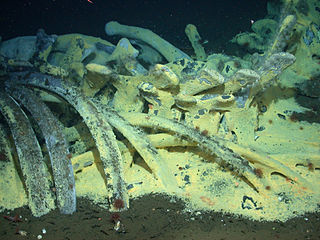
A whale fall occurs when the carcass of a whale has fallen onto the ocean floor at a depth greater than 1,000 m (3,300 ft), in the bathyal or abyssal zones. On the sea floor, these carcasses can create complex localized ecosystems that supply sustenance to deep-sea organisms for decades. This is unlike in shallower waters, where a whale carcass will be consumed by scavengers over a relatively short period of time. Whale falls were first observed in the late 1970s with the development of deep-sea robotic exploration. Since then, several natural and experimental whale falls have been monitored through the use of observations from submersibles and remotely operated underwater vehicles (ROVs) in order to understand patterns of ecological succession on the deep seafloor.

The Monterey Bay Aquarium Research Institute (MBARI) is a private, non-profit oceanographic research center in Moss Landing, California. MBARI was founded in 1987 by David Packard, and is primarily funded by the David and Lucile Packard Foundation. Christopher Scholin serves as the institute's president and chief executive officer, managing a work force of approximately 220 scientists, engineers, and operations and administrative staff.
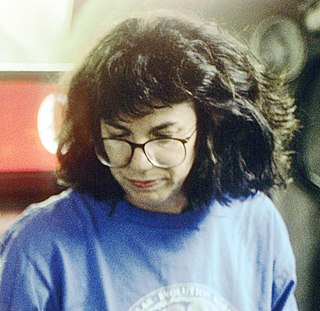
Colleen Cavanaugh is an American academic microbiologist best known for her studies of hydrothermal vent ecosystems. As of 2016, she is the Edward C. Jeffrey Professor of Biology in the Department of Organismic and Evolutionary Biology at Harvard University and is affiliated with the Rowland Institute. Cavanaugh was the first to propose that the deep-sea giant tube worm, Riftia pachyptila, obtains its food from bacteria living within its cells, an insight which she had as a graduate student at Harvard. Significantly, she made the connection that these chemoautotrophic bacteria were able to play this role through their use of chemosynthesis, the biological oxidation of inorganic compounds to synthesize organic matter from very simple carbon-containing molecules, thus allowing organisms such as the bacteria to exist in deep ocean without sunlight.
Osedax mucofloris is a species of bathypelagic Polychaetes that is reported to sustain itself on the bones of dead whales. Translated from the mixed Greek and Latin used in scientific names, "Osedax mucofloris" literally means "snot-flower bone-eater", though the less-accurate "bone-eating snot-flower worm" seems to be the form actually used. The species is found in North East Atlantic where it is abundant.
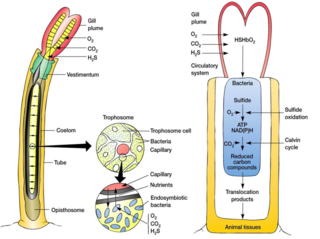
A trophosome is a highly vascularised organ found in some animals that houses symbiotic bacteria that provide food for their host. Trophosomes are located in the coelomic cavity in the vestimentiferan tube worms and in symbiotic flatworms of the genus Paracatenula.

Osedax roseus is a species of bathypelagic polychaete worm that lives at abyssal depths and is able to sustain itself on the bones of dead whales. The species is found in the North East Pacific.
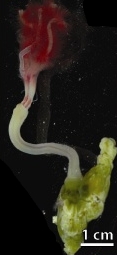
Osedax rubiplumus is a species of bathypelagic Polychaetes that is reported to sustain itself on the bones of dead whales.

Sabella spallanzanii is a species of marine polychaete worms in the family Sabellidae. Common names include the Mediterranean fanworm, the feather duster worm, the European fan worm and the pencil worm. It is native to shallow waters in the northeastern Atlantic Ocean and the Mediterranean Sea. It has spread to various other parts of the world and is included on the Global Invasive Species Database.
Osedax japonicus is a species of bathypelagic polychaete tube worm that lives at great depths on the seabed and is able to sustain itself on the bones of a dead whale. It was first described in 2006 from a sunken sperm whale carcase near Kyushu, Japan.
Osedax priapus is a species of bathypelagic Polychaetes that is reported to sustain itself on the bones of dead whales.
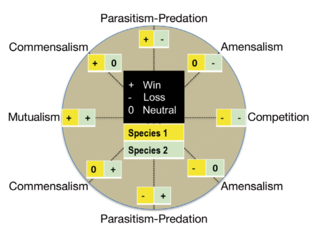
Microbial symbiosis in marine animals was not discovered until 1981. In the time following, symbiotic relationships between marine invertebrates and chemoautotrophic bacteria have been found in a variety of ecosystems, ranging from shallow coastal waters to deep-sea hydrothermal vents. Symbiosis is a way for marine organisms to find creative ways to survive in a very dynamic environment. They are different in relation to how dependent the organisms are on each other or how they are associated. It is also considered a selective force behind evolution in some scientific aspects. The symbiotic relationships of organisms has the ability to change behavior, morphology and metabolic pathways. With increased recognition and research, new terminology also arises, such as holobiont, which the relationship between a host and its symbionts as one grouping. Many scientists will look at the hologenome, which is the combined genetic information of the host and its symbionts. These terms are more commonly used to describe microbial symbionts.

Xenoturbella bocki is a marine benthic worm-like species from the genus Xenoturbella. It is found in saltwater sea floor habitats off the coast of Europe, predominantly Sweden. It was the first species in the genus discovered. Initially it was collected by Swedish zoologist Sixten Bock in 1915, and described in 1949 by Swedish zoologist Einar Westblad. The unusual digestive structure of this species, in which a single opening is used to eat food and excrete waste, has led to considerable study and controversy as to its classification. It is a bottom-dwelling, burrowing carnivore that eats mollusks.
Carcinonemertes errans is a ribbon worm in the family Carcinonemertidae. It lives in symbiosis with the Dungeness crab, consuming the crab's developing eggs. In 1980 it was implicated in the collapse of the Dungeness crab fishery in central California.

Xenoturbella profunda, the purple sock or sock worm, is a marine, benthic, deep-water worm-like species that belongs to the genus Xenoturbella. It was discovered in eastern Pacific Ocean by a group of Californian and Australian scientists. The species was described in 2016 from seven specimens.
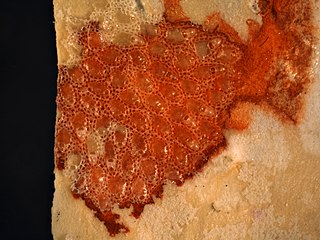
Chorizopora brongniartii is a species of bryozoan in the family Chorizoporidae. It is an encrusting bryozoan, the colonies forming spreading patches. It has a widespread distribution in tropical and temperate seas.















